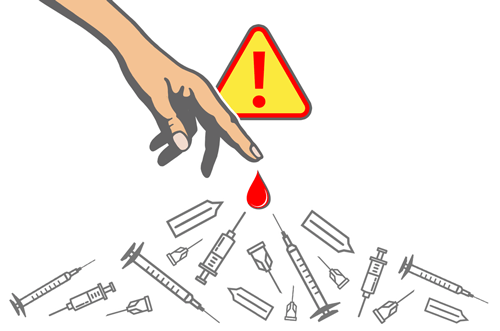
Before you injure yourself or before you hire a bad disposal company, read this guide and AVOID getting Hepatitis B or making any expensive mistakes.
As a Medical Doctor (MD) and expert in sharps container disposal, I created this “Definitive Guide” to answer all your questions about: risks, proper disposal methods, disposal regulations, and container purchasing, selection and evaluation.
#1 What goes in a sharps container and what doesn’t?
Before we can go into the proper disposal of sharps and sharps containers, let’s briefly go into what actually goes into a sharps container, and what does NOT
According to OSHA (Occupational Safety and Health Administration), here is a list of what goes and does NOT go into sharps containers:


#2 What are the risks to improper sharps disposal?

Sorry to disappoint our Walking Dead fans, but improper disposal of sharps containers won’t be the cause of the Zombie Apocalypse in America because of our stringent regulations, laws, and guidelines.
But you can do put yourself and others at serious risk…
Getting jabbed with a used needle could result in contracting a blood borne virus (BBV) such as Hepatitis or even HIV. According to the:
1. FDA, up to 850,000 people are injured every year by sharps.
2. WHO (World Health Organization), 32% new Hepatitis B infections occur due to improper disposal of contaminated syringes.
If that doesn’t convince you to store and dispose of your sharps correctly, I don’t know what will!
You may be sorry if you don’t read this…
#3 How to Safely Dispose of Sharps Containers

The safe disposal of sharps procedure begins with placement of all needles and other sharps in a disposal container immediately after use.
Proper sharps disposal also entails storing the container in a safe location, and keeping sharps and disposal containers far out of reach of children and pets.
The OSHA sharps container height recommendations outline (more regulations are section 4) that the ideal standing installation height for a fixed sharps disposal container is 52 to 56 inches.
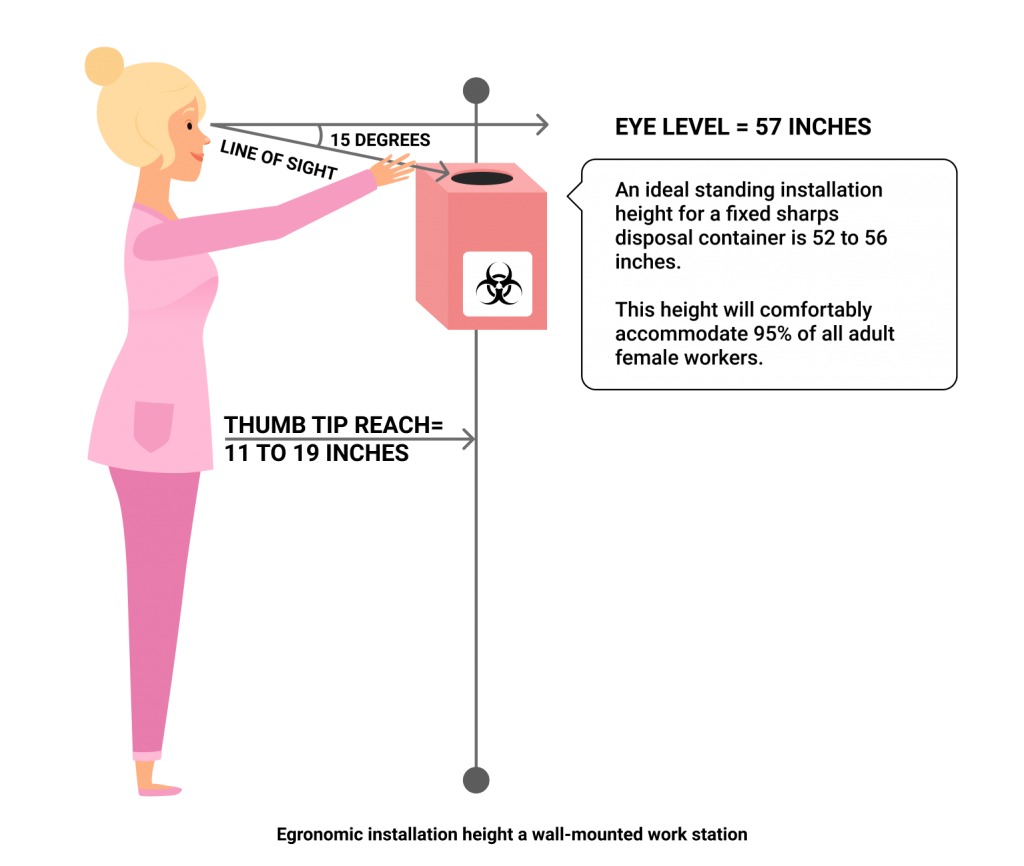
9 Sharps “Do NOTs”
We get a lot of FAQs like:
- Can I throw my sharps in the regular trash?
- Are sharps containers reusable?
- What do you do with a sharps container when it’s full?
So we summarized the following 9 “do NOTs” from FDA and CDC guidelines to help keep yourself, children, sanitation workers, and others safe from needle stick injuries.
- Do NOT throw loose sharps in the trash.
- Do NOT put sharps in recycling bins.
- Do NOT flush sharps down the toilet.
- Do NOT keep sharps containers where children can reach them.
- Do NOT use glass bottles, plastic water bottles, milk jugs or cartons, or soda cans as do-it-yourself sharps containers.
- Do NOT fill sharps containers past the fill line or three-quarters (3/4) full, and don’t force needles inside.
- Do NOT Put your sharps into the container immediately after use.
- Do NOT bend or break needles.
- Do NOT recap others’ needles; if you don’t have a sharps container, you may want to carefully recap your own needles.
Please be safe, and throw all your sharps into a proper sharps container.
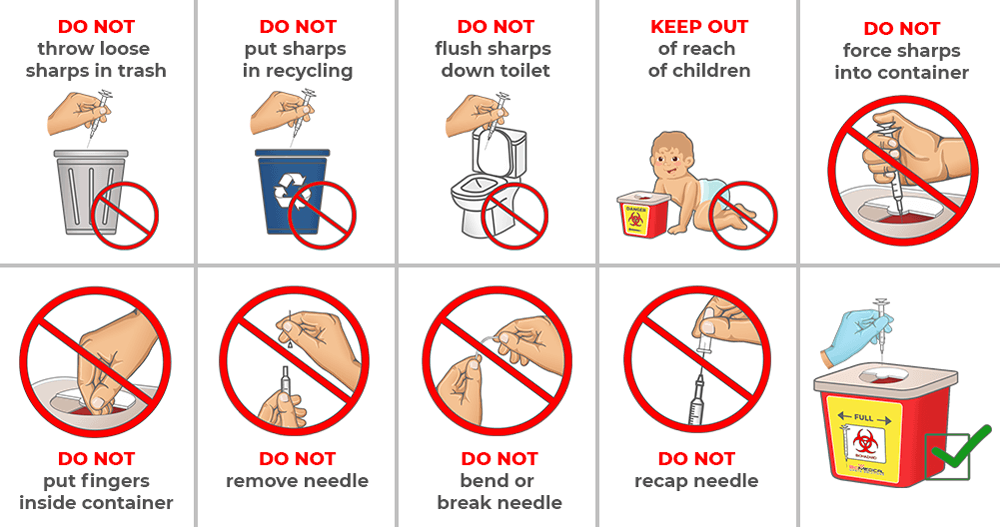
FAQ: How to open a sharps container?
We often get asked questions around how to open a sharps container or how to open a locked sharps container.
Generally, it is a bad idea to open a sharps container for any reason, as it could result in cuts and needle sticks.
Still you want to open your sharps container?
Again, I recommend you avoid opening them for any reason!
But, if you absolutely need to retrieve something accidentally locked in a container, you can sometimes unlock them with a screwdriver.
There’s a very good reason these containers have been made very difficult to open, because they’re meant to stay closed! Just like how pharmaceutical companies make pill containers hard to open for children, they’ve made sharps containers hard to open for adults because there is a huge risk of serious injury.
FAQ: How do I dispose of a full sharps container?
What should be done when a sharps container is full?
Do not wait until the container is completely full.
Here’s why: Overfilling a disposal container increases the risk of accidental needle-stick injury.
Dispose of your container when it is about three-quarters (3/4) full.
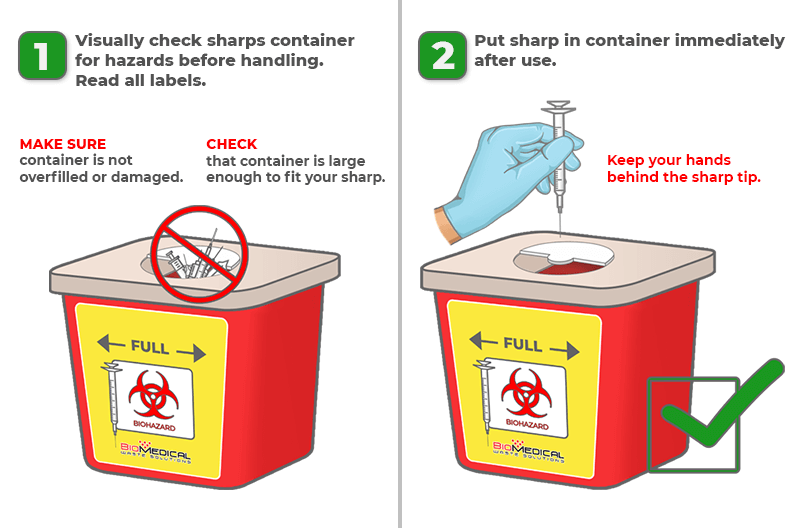
#4 Where Can I Dispose of Sharps Containers?
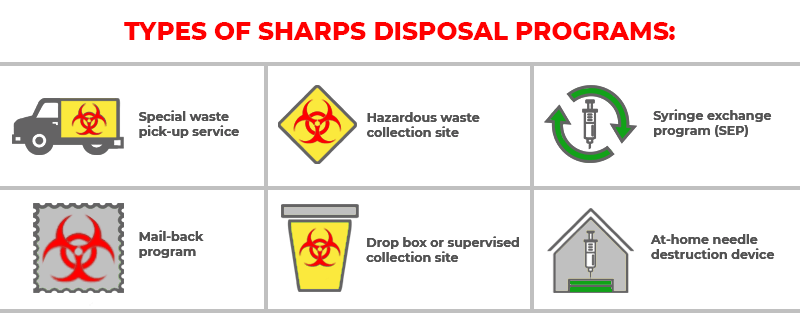
Where you dispose of sharps usually depends on whether it’s a sharps disposal for your home or organization.
Home Sharps Container Disposal
For home sharps disposal, it’s important to check for information specific to your state, as almost every state and local government has its own regulations and guidelines to provide the best way to dispose of it.
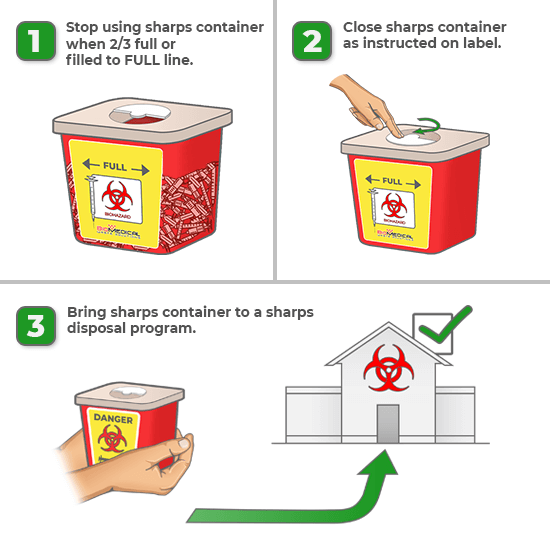
#5 Top Sharps Container Disposal Companies
Are you looking for a top sharps container disposal company?
Look no further. We’re it.
We’re affordable, reliable, and 100% compliant.
Our job is to provide you with the highest quality sharps container disposal at the right price, while remaining completely in federal and state regulations.
In addition, for some cases, performing a shredding for Penn MedWaste needed as an aid for incineration process.

#6 Sharps Container Disposal Regulations
Federal agencies that regulate medical waste and sharps container disposal include the Environmental Protection Agency (EPA), the OSHA, and the U.S. Department of Transportation (DOT). The Centers for Disease Control and Prevention (CDC) provides guidance, but has no formal regulations.
All medical waste producers are legally responsible for their sharps container disposal as per “The Needlestick Safety and Prevention Act of 2000”, which mandates healthcare professionals to maintain exposure control plans to minimize the potential for sharps related accidents, such as needle sticks.
Brief History of Regulated Sharps Disposal in America:
In 1988, a famous act namely Medical Waste Tracking Act (MWTA) was addressed to handle the disposal of medical waste and sharps in coastal areas. A two-year program was implemented in the affected areas (New York, New Jersey, Connecticut, Rhode Island, and Puerto Rico). This act expired on June 21, 1991.
During that time, EPA gathered all information and performed medical waste related studies and together with MWTA, they managed to look at several treatment technologies that were available at that time involving incinerators, microwave units, and several varieties of mechanical and chemical systems that can be used for reducing the waste. This resulted in a different local regulation of medical waste and sharps management implemented in each state, such as Medical Waste Management 2015, one of the recent regulations for California State.

#8 Selecting, Evaluating, and Using Sharps Containers
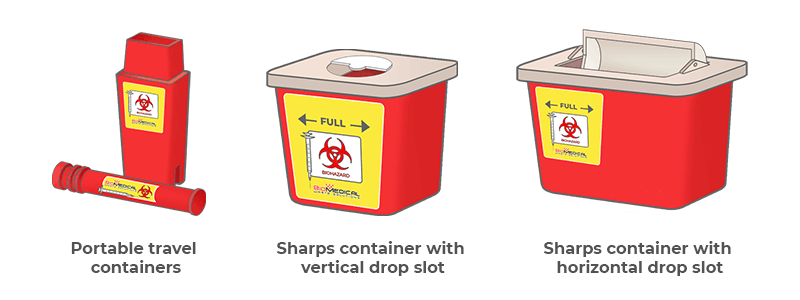
First off, “what are sharp disposal containers”?
| “A sharps disposal container is made from durable plastic used to safely get rid of needles and various sharp medical instruments, like IV catheters and disposable blades used in medical procedures. In the United States they’re usually red in colour, other parts of the world they can be found in a yellow color also.” |
Both the FDA and CDC have written guidelines to recommend the structure of sharps bins used for disposal. Here are some best practices to follow when selecting and installing a sharps container:
- The sharps container must be placed somewhere visible, ideally at eye-level.
- The container should be located in an area free of obstacles.
- The container should be big enough to accommodate the quantity of sharps produced in the area.
- The container should be well-sealed and fully leak-proof, ideally made of heavy plastic and clearly labelled as a sharps container.
- The sharps container needs to be fully anchored and stabilized to prevent any movement.
- The container should remain upright during use.
- Filled only to 3/4 of its capacity, fortunately most sharps containers’ have “filled” line to make it easy to know when you’ve reached 3/4. Once you reach 3/4 then it’s time to replace the container.
It’s important to select a sharps box for disposal that is well-sealed and leak-proof to fully contain all sharps and adequately safeguard people who handle the waste, and are not harmful to the environment.
What is NOT a “sharps container”?
Naturally, by now you realize what a sharps container is, you know to refrain from putting sharps in an unregulated garbage container (regular trash can) and the recycling bin.
However, to the medical professional, it’s important to know the difference between a sharps container and a medical waste disposal container. We’ve created this handy chart to help you understand the difference and where to put your medical waste into the appropriate medical waste container – it’s like sorting recycling at home, but way more hazardous!
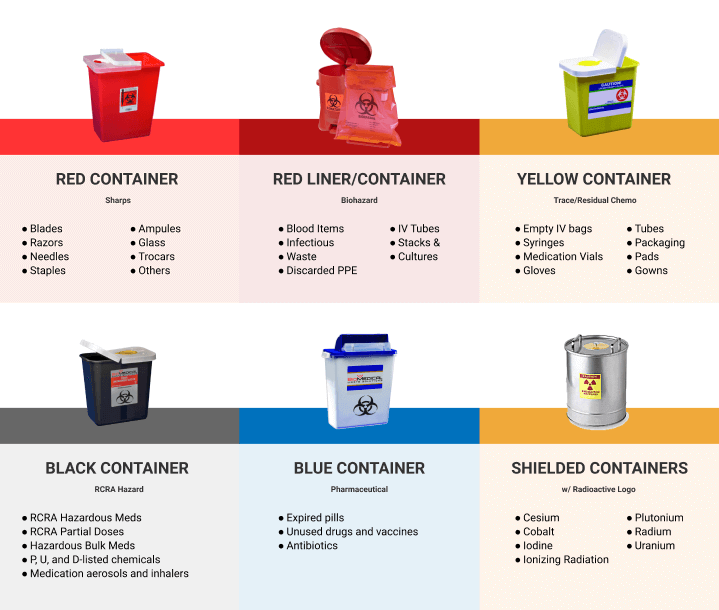
#10 Mail-In Sharps Disposal
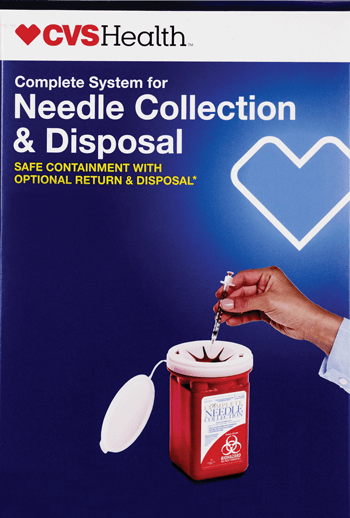
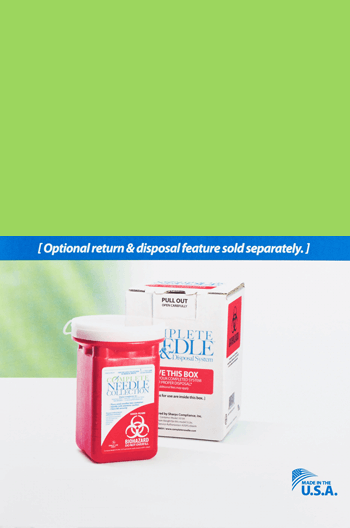
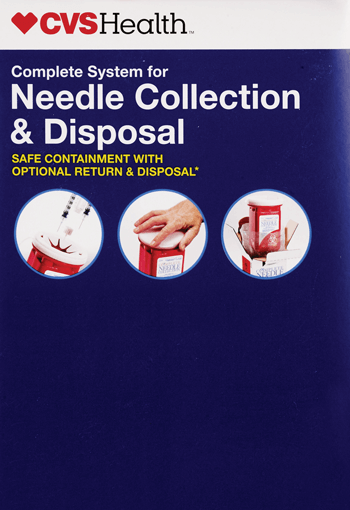
A variety of companies offer mail-back sharps disposal programs (like CVS, which is featured in image above). These generally are only suitable for residential, small scale and rural use
The general process to mail your sharps container disposal is:
- Use your sharps
- Place sharps into a container
- Insert container into a prepaid box
- Fill out a form
- Mail the box back to the disposal company
A mail in program is relatively easy to use, and most come with prepaid postage (CVS’s costs extra) and is compliant with all Federal, State, and United States Post Office regulations and standards.
BONUS: Sharps Disposal Poster
Is it a crazy idea to share our sharps disposal poster online and via email our sharps disposal poster? No because doing so will help prevent needlestick injuries.
PDF Printer Version (please print off)
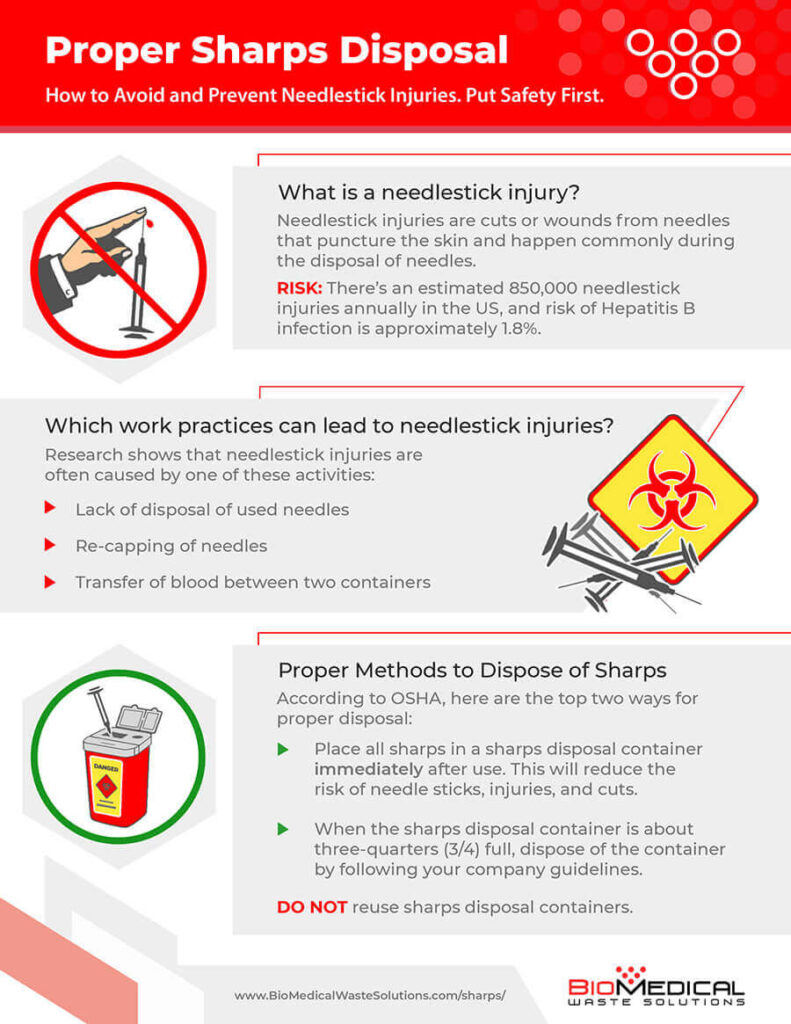
Conclusion
As you can see from this article, great care goes into disposing of sharps containers, and the way it is disposed is dependent on what category of sharps it is and government regulations. We hope you find it easier to properly dispose of your sharps.



